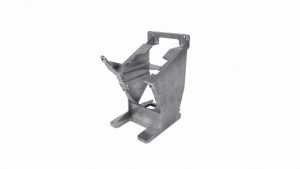Casting Study: Central support for electrical, mechanical & optical parts in detail equipment
This component immediately catches the viewer’s eye because of its size, volume and associated weight. However, these dimensions are necessary for the central support unit in the dental field in order to enable the inclusion of optical, electrical and mechanical components for the dental treatment.
A large number of small-format connection preparations and threads for fastening circuit boards, microchips and screens as well as precision engineering tools and connection peripherals show what the component is made of. The cast part only appears very complex at second glance. At first glance, the cast part appears thick-walled and coarse, but on closer inspection the precision is recognizable. The tolerance requirements are in the range of 0.05 to 0.2 mm, in the predominant range around 0.1 mm. When it came to implementing the casting technology, the jury noticed the intelligent sprue design. The sprue is connected inside the cross member.
The sprue is separated by punching in two separate work steps. A FRECH DAW 200 die-casting machine is used to produce the casting, including the sprue, which weighs more than two kilograms and meets the specified low tolerance requirements. Before final assembly, the central carrier unit is surface-passivated.
We congratulate the entire team of Kaspar Lüther GmbH & Co. KG from Gunzenhausen on the implementation of this interesting component!
